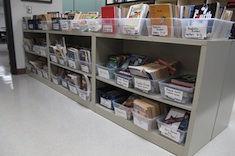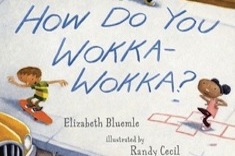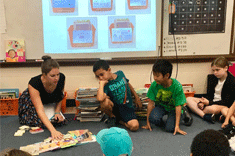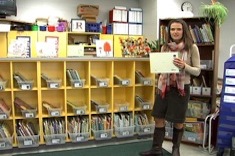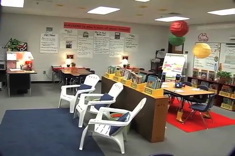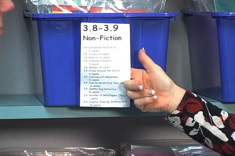It won’t work. Can I make it work? No, I can’t make it work. This was my circle of thought during the first month of school. I had recently finished assessing my second-grade students individually to learn about them as readers. As I processed the hard and soft data, I was overwhelmed with the notion that my current collection of books wasn’t what my readers needed. At times, I felt paralyzed because I didn’t know where to start or what to change with my classroom library.
Previous students had embraced the classroom library with enthusiasm and eagerness. I had expected to make the same observations this year, but as I looked around my classroom, I saw readers not really reading. I saw stacks of books being rearranged. I saw lots of picture books being selected. I saw easy picture books of favorite characters being reread and reread. I saw a lot of book shopping, and I saw a lot of eyes wandering around. At one point, I even saw chunks of pages being skipped as a reader “read” through a book. That was not the image I was striving for during reading workshop.
I thought about the collection of books in my classroom. I had carefully selected these books to share with my students. To build this classroom library I had blended bits and pieces from previous years of teaching third grade, kindergarten, and a multi-age first- and second-grade classroom. I had personally read many of them, and wanted my students to enjoy them as much as I had. Curating and collecting books for just over 20 years has been fun and an adventure, but my observations were telling me that my curating and collecting wasn’t just right, right now.
Realizing I didn’t have books to match the students I was working with this school year was hard. Once I accepted it, my mind could focus with enthusiasm on what was needed next. Essentially, I would be curating and collecting books again, but before I could start, I needed to look at my data. My students were successful word readers. Their knowledge of decoding and attacking words had flourished during first grade. However, our rate of reading was a bit slow and robotic-sounding. They seemed a bit too confident with sight words and didn’t notice careless errors when reading them. I had a few students losing track of print, skipping a whole line of print at a time. Our retellings covered the gist of the story but lacked specific vocabulary or details. When responding to their reading, their thinking was brief and in general terms. Yet I could tell they enjoyed books and wanted to read them.
I wondered if perhaps my current classroom library could work if I conferred with my readers and offered book suggestions. I began talking to my students and suggesting book titles to them, only to make a sizable discovery. Chapter books were a new adventure for most of them. Once I knew this, my concerns mentioned above made sense; our classroom library was overwhelming. My classroom library is quite large because I’ve always filled it with books to support readers at different levels within second grade for the entire year and provided a variety of genres. Once I came to these realizations, I could come to grips with the idea that less is more and temporarily pack away books and discover just what we needed.
One evening I stayed after school to study my current classroom library and begin the packing-up process. I started by confirming the level of a few books in my classroom. As I looked at Henry and Mudge by Cynthia Rylant, a good series for the beginning of second grade, and Magic Tree House by Mary Pope Osborne, a good series to end second grade with, I instantly saw reasons I needed to pack away several books to support my readers.
| Colored illustrations to support text and comprehension | Fewer black-and-white detailed illustrations |
| Larger font size | Smaller font size |
| More white space between words and lines of print | Less white space on a page, requiring consistent tracking of print |
| Simpler story structure | Longer plot |
| Sentence structure usually has one thought | More complex sentence structure |
| Most vocabulary is known and common | Unfamiliar vocabulary requiring more decoding and thinking |
| Some dialogue | Lengthier amounts of dialogue |
I knew in the back of my mind these differences between book features, but I had never put them side by side and processed them. Once I could visually see the difference, I quickly continued the packing-up process and adjusted our classroom library based on our current reading needs. When I looked closely at the series Babymouse and Squish by Jennifer Holm and Matthew Holm, I found the format friendly and highly engaging, but I was surprised by the sophistication of the vocabulary. I temporarily packed them away.
The much-loved series Geronimo Stilton suddenly felt overwhelming with all the doodles, busy pages of print, and varying font sizes. Something that jumped out to me was the amount of print on a page and the lack of white space between lines. For these reasons the following series were packed away: A to Z Mysteries, Jigsaw Jones, Puppy Place, Herbie Jones, and Sister Magic. I remembered that last year’s class struggled with Judy Moody’s plots early in the year, so I packed this series away too. Packing these books away helped me easily set goals for my students and decide when to bring these books back out for us to enjoy later in the year.
As I left my room that evening, I was sad. My classroom library looked bare, and I had 20 readers who needed books. I had some just-right books for us, but I needed some new titles. I texted a good friend who had been teaching second grade for a while, and she offered me some great titles to help me begin curating and collecting the books we needed early in the year.
Classroom Library Suggestions
All of these series have several books with the same characters, which made restocking our classroom library easier. Some of these books were ones I already had, and about half were new to me.
Meet Mr. and Mrs. Green by Keith Baker
Tugg and Teeny by Patrick Lewis
Frog and Friends by Eve Bunting
Judy Moody and Friends: Triple Pet Trouble by Megan McDonald
Mouse and Mole: Fine Feathered Friends by Wong Herbert Yee
Houndsley and Catina by James Howe
Mr. Putter and Tabby Drop the Ball by Cynthia Rylant
Young Cam Jansen and the Lost Tooth by David A. Adler and Susanna Natti
Fox Outfoxed by James Marshall
Frog and Toad Are Friends by Arnold Lobel
Katie Woo: Boss of the World by Fran Manushkin
Keeker and the Sneaky Pony by Hadley Higginson
Amelia Bedelia Means Business by Herman Parish and Lynne Avril
The Littles Make a Friend by John Peterson
Commander Toad by Jane Yolen
As I packed up some of my books, I thought I would be clever and place the storage tubs in the hallway and the students wouldn’t notice. That didn’t work. They greeted me with lots of questions the next day during reading workshop. I was honest and explained that we had too many books and that our special reading meetings had taught me that we needed different things right now. They were really receptive and interested in the new books I said would be coming. As they went book shopping in our revamped classroom library, I saw them select books that would provide more focus and independence. Our reading workshop was becoming the image of what I had hoped it would be.
Here is the next wave of books to be added to our classroom library:
Cam Jansen: The Mystery of the Dinosaur Bones by David A. Adler and Susanna Natti
Ivy and Bean by Annie Barrows
Horrible Harry in Room 2B by Suzy Kline
Captain Awesome to the Rescue! by Stan Kirby and George O’Connor
Magic Bone: Be Careful What You Sniff For by Nancy Krulik
Humphrey’s Really Wheely Racing Day by Betty G. Birney
Heidi Heckelbeck Has a Secret by Wanda Coven
Greetings from Somewhere: The Mystery of the Gold Coin by Harper Paris
The Critter Club: Amy and the Missing Puppy by Callie Barkley
Mercy Watson: Something Wonky This Way Comes by Kate DiCamillo
Sophie Mouse: A New Friend by Poppy Green and Jennifer A. Bell
Violet Mackerel’s Personal Space by Anna Branford
Roscoe Riley Rules: Never Glue Your Friends to Chairs by Katherine Applegate
The Kingdom of Wrenly: The Lost Stone by Jordan Quinn

